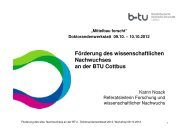Multilevel Graph Clustering with Density-Based Quality Measures
Multilevel Graph Clustering with Density-Based Quality Measures
Multilevel Graph Clustering with Density-Based Quality Measures
Create successful ePaper yourself
Turn your PDF publications into a flip-book with our unique Google optimized e-Paper software.
4.5 ScalabilityModularity by Refinement Method (large set)mean modularity0.525 0.530 0.535 0.540 0.545none SGR−density CGR KLFigure 4.8: Mean Modularity by Refinement Method (large set)Altogether Kernighan-Lin refinement reliably improves the clusterings by a smallamount but requires considerably more runtime. Therefore it should be used inplace of sorted greedy refinement only when best clusterings are searched. Similaror better modularity improvements might be easily achievable by other refinementmethods in less time.4.5 ScalabilityThe purpose of this section is to experimentally study how well the runtime of thealgorithms scales <strong>with</strong> the graph size. The considered configurations are the multilevelKernighan-Lin refinement (KL), sorted greedy refinement by density-fitness(SGR-density), complete greedy refinement (CGR) and the raw graph coarsening<strong>with</strong>out refinement (none). For all other parameters the default values are used.The runtime of all graphs and algorithm has to be measured on the same computer.Thus only a subset of 24 graphs from the large graph collection is used. The graphsare also marked in the graph table in the appendix.Figure 4.9a shows the total runtime of the algorithms versus the number of vertices.In addition Figure 4.9b shows the computation time of the coarsening phase,which equals the configuration none. The time spend on sorted greedy refinementis included. In order to show the influence of the vertices the names of three largergraphs and their vertex count are inserted into the figure. The complete runtimemeasurements of each graph can be found in the appendix in Table B.5.Of course the runtime not only depends on the number of vertices but also onthe edges. On the other hand the number of edges mostly scales <strong>with</strong> the verticesbecause nearly all graphs have a similar mean vertex degree. The graphs eatRSand hep-th-new main are the two largest graphs of the collection. Both have morethan three times more edges than other graphs of similar vertex count (for example75






